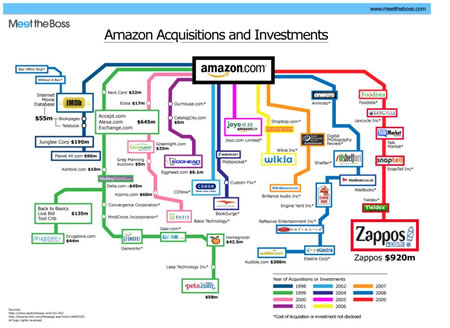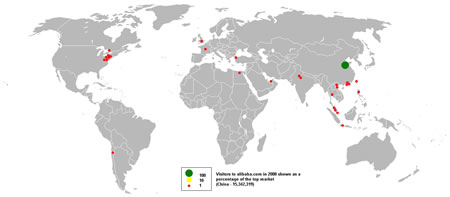
Exploring the mapping of personality and brand in cultural change | Amazon+Zappos and the Endless(.com)…potential.
Amazon CEO Jeff Bezos has a point of view — and his strategies, intriguingly, focus on one compelling degree of index. Community attention. You might notice, in having any degree of relationship with Amazon, that progressively, the “connectedness” of your link to them can, and will, if you allow it, deepen. What that means really comes from the top of the organization — the headwaters of Amazon, Mr. Bezos himself. And truly, any brand, and any relationship is ultimately only as good as its funding “glue”; that is the audience. Strong, continuously re-identifying relational adhesion either builds, and mends the connections to audience links to brand, or progressively it dissipates.
The acquisition of Zappos spells a deepening of the understanding of brand in relationship – one in a string of consumer focused brand alliances now owned by Amazon. Zappos, however, extends the power of relationship management to new degrees; and it’s the Amazon strategy to learn from those lessons, even though they’ve offered to allow Zappos to exist unfettered by Amazon management. Patricia Edwards, a retail analyst with Storehouse Partners offers that, “They didn’t buy Zappos just because they sell shoes but because of how they do it,” She offers “You can generate incredible customer loyalty through a good experience.” And what happens in that model is the opening, which becomes the second, the third, the story shared and the building community. This, too, is the premise of Zappos.
Zappos has developed a expansively growing, loyal audience over the years. Culturally, it’s loose and roaming, in terms of management style: its customer service staff members aren’t strictly tethered to call times, phone regimens or scripts. A principle, too, is free shipping and free returns for up to a year. And, to the nature of community development, social connections are crucial assets: Zappos Twitter account has more than a million followers.
Contrasting, Amazon’s customer service contacts aren’t always easily located on its websites. Free shipping, for example, is limited — for some orders over $25 and for people who sign up for the $79 Amazon Prime service. Amazon’s Twitter and other social media is still very much in the beginning stages. To reference, Amazon Twitter account has a relatively modest 5,000 followers; rather than being relationship developing, it’s more about deals — and this might be part of the challenge in the current Amazon modeling. Transactions, less than community. Zappos will be an aid on this front, in support of Bezos’ statement that he “gushed that he gets “weak-kneed” thinking about customer-obsessed companies like Zappos, and praised Zappos’ “totally unique culture.”
The concept of social network and expansiveness is broadly distributed, every employee, not just the CEO, is empowered to do social media. Registration and management embrace relatively loose guidelines to manage social media applications. Amazon, on the other hand, is very controlled in the orientation of customer engagement. It’s not the first time that it’s studied Zappos — it created a competitive modeling, first — Endless.com. This, however, wasn’t as successful, barely making a dent in the market. The scale of access and consumer connection is dynamic: this June, Zappos.com attracted more than 4.4 million unique visitors while Endless.com had 770,000 unique visitors.
There’s another model, to examining retail relationships, and the new telling of this proposition: Alibaba’s TaoBao, an e-commerce site of immense dimensions operating in China. To the concepts of consumer attentiveness, that’s all it is: relationship attention and matching. There’s no charge (free, to Chris Anderson’s dictum) for entering the retail sprawl of TaoBao — and that was the inherent killer of eBay’s reach into China. Being “free”, TaoBao knocked out eBay’s brand entry, and supervised their egress from the market.

TaoBao’s positioning, to Alexa analyses, suggests a brand touchpoint to community of 100% of a 15 billion market. Simple, the proposition: “the largest Internet retail website in China with more than 75 percent of the Chinese-domestic online consumer market. It provides the most comprehensive product offering ranging from collectibles and hard-to-find items to mainstream retail categories such as consumer electronics, clothing and accessories, sporting goods and household products. As of the end of March 2009, it served more than 120 million registered users and showcased up to 300 million products on its website. In 2008, Alibaba Group announced it will be investing more than US$700 million in Taobao in the next five years.
Daily transaction volume on Taobao (gross merchandise volume or GMV) exceeded US$70 million in March 2009, compared with about US$60 million in December 2008. Taobao is the primary online shopping destination for the largest online population in the world.
The real issue is about love. Brand love. And this focus and capacity to nurture and evolve community and relationships is at the heart of business strategy. With that in play, engagement, continuance, expansion and, most importantly, stories shared, in community, building brand.
“There’s a story, it’s a good one, it’s a great brand, it’s mine and I recommend it” — spread the news.
tsg
….
Brands | love | humans:
http://blog.girvin.com/
reel: http://www.youtube.com/user/GIRVIN888
personal: https://tim.girvin.com/index.php
communities:
TED community: http://www.ted.com/index.php/profiles/view/id/825
LinkedIn: http://www.linkedin.com/in/timgirvin
Facebook: http://www.facebook.com/people/Tim-Girvin/644114347
Twitter: http://twitter.com/tgirvin